wheel size DODGE DURANGO 2022 Vehicle Warranty
[x] Cancel search | Manufacturer: DODGE, Model Year: 2022, Model line: DURANGO, Model: DODGE DURANGO 2022Pages: 200, PDF Size: 6.72 MB
Page 53 of 200
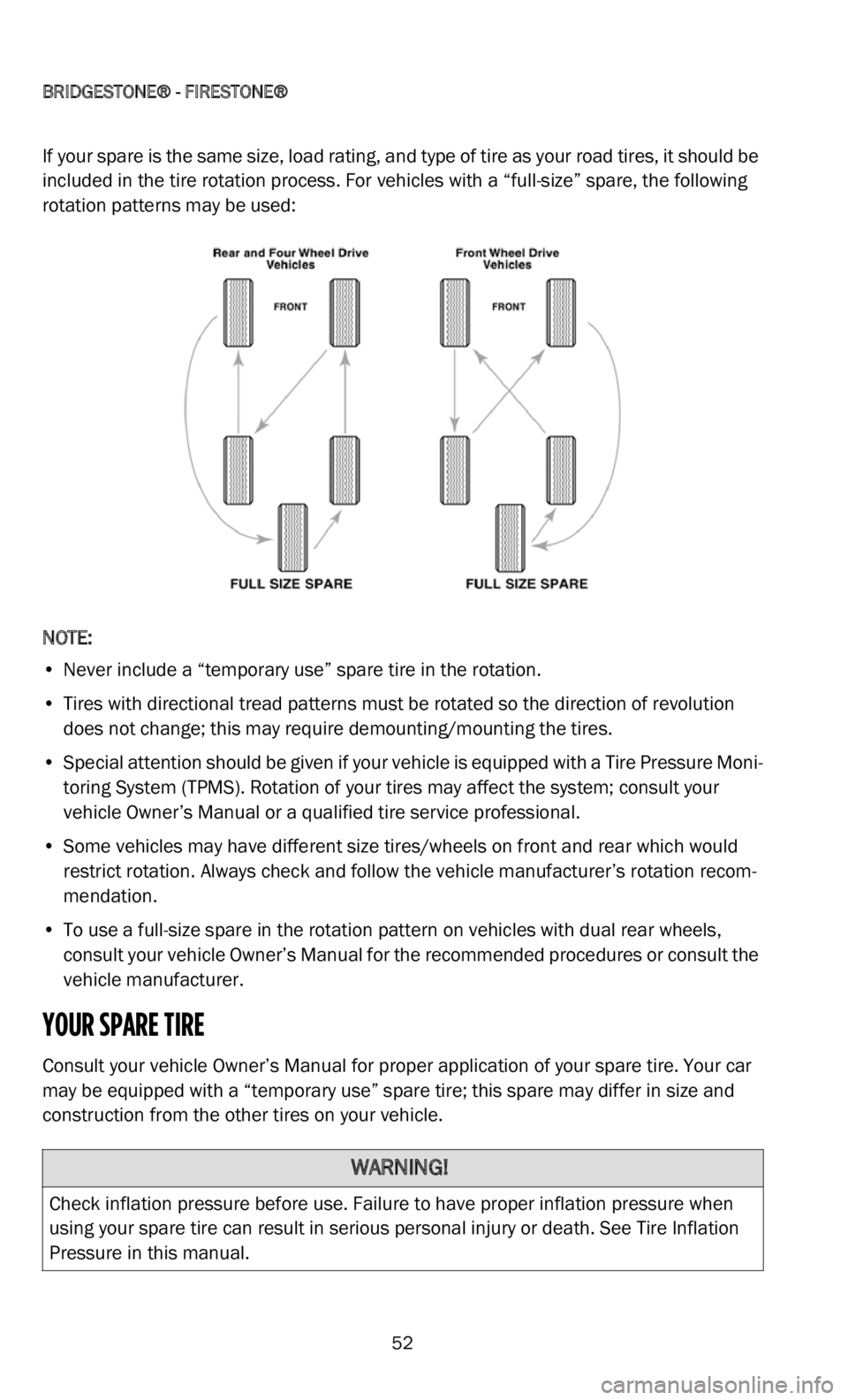
BRIDGESTONE® - FIRESTONE®
52
If your spare is the same size, load rating, and type of tire as your road tires, it should be
included in the tire rotation process. For vehicles with a “full-size” spare, the following
rotation patterns may be used:
NOTE:
• Never include a “temporary use” spare tire in the rotation.
•
Tires with directional tread patterns must be rotated so the direction of revolution
d
oes not change; this may require demounting/mounting the tires.
• S pecial attention should be given if your vehicle is equipped with a Tire Pressure Moni -
t
oring System (TPMS). Rotation of your tires may affect the system; consult your
v e
hicle Owner’s Manual or a qualified tire service professional.
• S ome vehicles may have different size tires/wheels on front and rear which would
r
estrict rotation. Always check and follow the vehicle manufacturer’s rotation recom -
mendation.
• T o use a full-size spare in the rotation pattern on vehicles with dual rear wheels,
c
onsult your vehicle Owner’s Manual for the recommended procedures or consult the
vehicle manufacturer.
YOUR SPARE TIRE
Consult your vehicle Owner’s Manual for proper application of your spare tire. Your car
may be equipped with a “temporary use” spare tire; this spare may differ in size and
construction from the other tires on your vehicle.
WARNING!
Check inflation pressure before use. Failure to have proper inflation pressure when
using your spare tire can result in serious personal injury or death. See Tire Inflation
Pressure in this manual.
Page 54 of 200
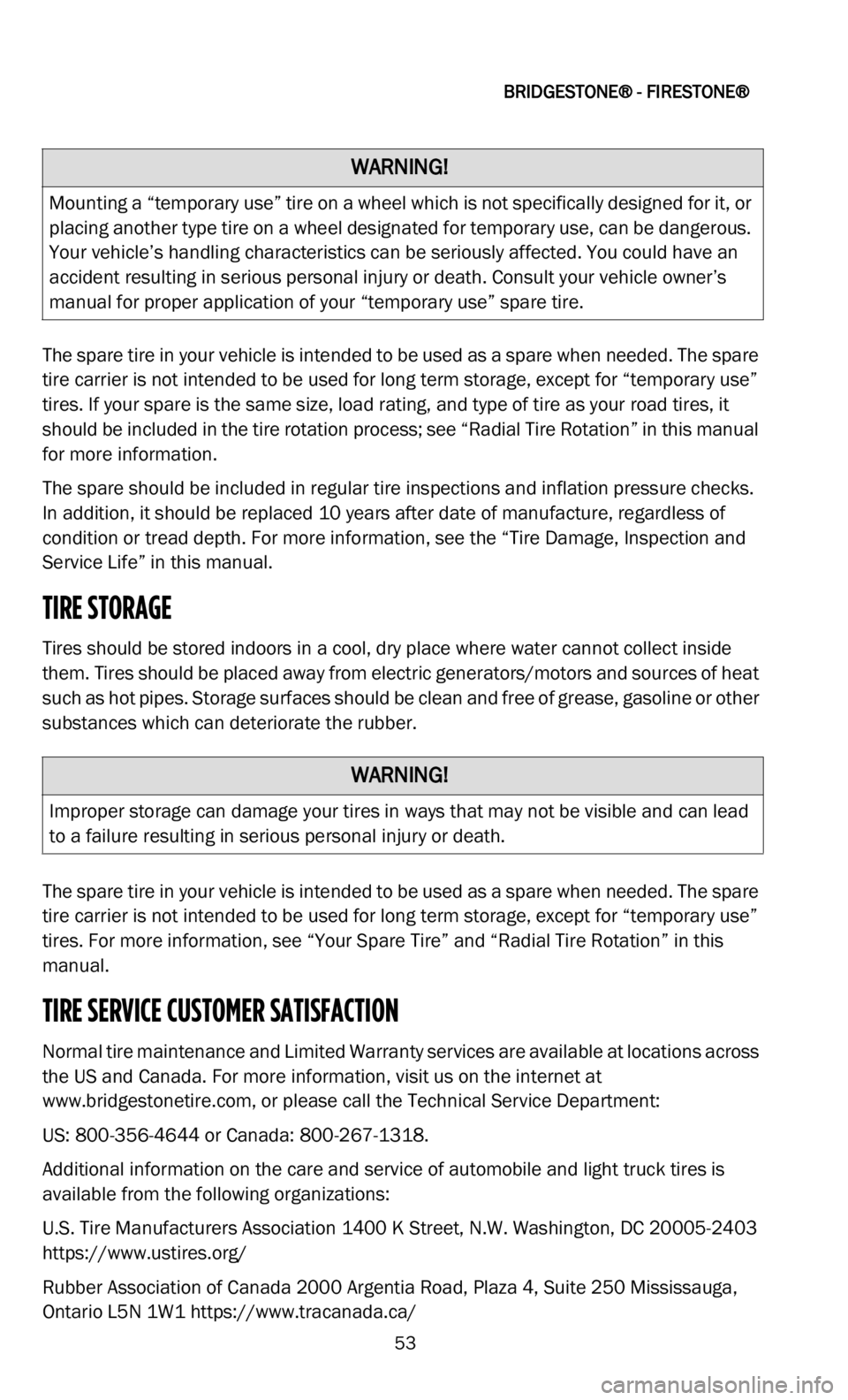
BRIDGESTONE® - FIRESTONE®
53
The spare tire in your vehicle is intended to be used as a spare when needed. The spare
tire carrier is not intended to be used for long term storage, except for “temporary use”
tires. If your spare is the same size, load rating, and type of tire as your road tires, it
should be included in the tire rotation process; see “Radial Tire Rotation” in this manual
for more information.
The spare should be included in regular tire inspections and inflation pressure checks.
In
addition, it should be replaced 10 years after date of manufacture, regardless of
condition or tread depth. For more information, see the “Tire Damage, Inspection and
Service Life” in this manual.
TIRE STORAGE
Tires should be stored indoors in a cool, dry place where water cannot collect inside
them. Tires should be placed away from electric generators/motors and sources of heat
such as hot pipes. Storage surfaces should be clean and free of grease, gasoline or other
substances which can deteriorate the rubber.
The spare tire in your vehicle is intended to be used as a spare when needed. The spare
t i
re carrier is not intended to be used for long term storage, except for “temporary use”
tires. For more information, see “Your Spare Tire” and “Radial Tire Rotation” in this
manual.
TIRE SERVICE CUSTOMER SATISFACTION
Normal tire maintenance and Limited Warranty services are available at locations across
the US and Canada. For more information, visit us on the internet at
www.bridgestonetire.com , or please call the Technical Service Department:
US: 8 00-356-4644 or Canada: 800-267-1318.
A
dditional information on the care and service of automobile and light truck tires is
a v
ailable from the following organizations:
U.S. Tire Manufacturers Association 1400 K Street, N.W. Washington, DC 20005-2403
https://www.ustires.org/
Rubber Association of Canada 2000 Argentia Road, Plaza 4, Suite 250 Mississauga,
O n
tario L5N 1W1 https://www.tracanada.ca/
WARNING!
Mounting a “temporary use” tire on a wheel which is not specifically designed for it, or
placing another type tire on a wheel designated for temporary use, can be dangerous.
Your vehicle’s handling characteristics can be seriously affected. You could have an
accident resulting in serious personal injury or death. Consult your vehicle owner’s
manual for proper application of your “temporary use” spare tire.
WARNING!
Improper storage can damage your tires in ways that may not be visible and can lead
to a failure resulting in serious personal injury or death.
Page 58 of 200

BRIDGESTONE® - FIRESTONE®
57
RFT Tire Replacement
Do not replace or mix RFT tires with conventional tires, unless on an emergency/
t e
mporary basis. Conventional tires do not have run-flat capability and the handling
characteristics of the vehicle with these tires may be different. If a conventional tire is
used on an emergency/temporary basis, verify that its size, load capacity, inflation
pressure, and speed rating specifications meet the requirements of the vehicle. Replace
any conventional tire with the proper RFT tire as soon as possible.
RFT Tire Damage and Repair
No tire, regardless of its design or quality is indestructible. RFT tires can be ultimately
r e
ndered unusable due to a puncture or other road hazard as well as from improper
run-flat or low tire pressure operation. Some punctures may be repaired under certain
restrictions and prescribed procedures.
When driven flat or with low pressure, factors affecting reparability include vehicle speed,
l o
ad, and maneuvering; the amount of inflation pressure loss; and ambient temperature.
In any situation, the extent and location of direct damage from a puncturing object or
other road hazard are also critical factors.
RFT tires are not repairable in any of the following situations:
• I f the tire was operated with inflation pressure less than 15 psi (100 kPa).
•
Abrasion or other damage is present on the exterior tread, sidewall or bead areas.
•
Abrasion, wrinkling, or separation is present on the tire interior.
•
Any condition or damage is present that disqualifies repair of a conventional tire.
R
un-Flat Certified Retailers will fully inspect your tire, inside and out, to determine if the
t i
re can be repaired. Tire damage is not always visible from the outside and the tire must
be removed from the wheel for a complete inspection. For more information, see the
section “Tire Repairs” in this manual.
NOTE:
Some vehicle manufacturers do not recommend using repaired tires. Consult your
v e
hicle Owner’s Manual or contact the vehicle manufacturer before operating a repaired
tire on your vehicle.
Page 60 of 200

BRIDGESTONE® - FIRESTONE®
59
DOT Symbol and Tire Identification Number: The “DOT” symbol constitutes a certification
that the tire conforms to applicable US Department of Transportation (DOT) motor
vehicle safety standards (for tires). Following the “DOT” symbol is the tire identification
number, also known as the DOT serial number or code. For example:
The DOT symbol and tire identification number can be found on at least one sidewall near
th
e wheel. The other sidewall may have a partial serial code that excludes (e) and (f)
above.
Maximum Load and Inflation: T
he maximum load and maximum inflation pressure is
marked on each sidewall in metric and English units. For example:
MAX LOAD 685 kg (1,510 lbs) AT 240 kPa (35 psi) MAX PRESS
NOTE:
The load and inflation values marked on the tire sidewall are maximum permissible
v a
lues for the tire only. Never assume that these values are the actual maximum load
capacity or recommended tire pressure values for your vehicle. See “Tire Inflation Pres -
sure,” “Tips for Safe Tire Inflation,” and “Tips for Safe Loading” in this manual.
Ply Composition and Materials: T
he actual number of plies in the sidewall and tread area
and the generic name(s) of their cord material(s) are marked on at least one sidewall. For
example:
• T READ 2 PLY POLYESTER + 2 STEEL
•
SIDEWALL 2 PLY POLYESTER
R
adial: Radial ply tires will have the word "radial" on at least one sidewall. An “R” in the
t
ire size designation also indicates radial ply construction.
Tubeless or Tube Type: T
ires are marked as either “tubeless” or “tube type,” whichever
is applicable, on at least one sidewall.
(a) DOT Symbol (d) Tire Manufacturer’s Code
(b) Manufacture Plant Code (e) Week of Production (01-52)
(c) Tire Size Code (f) Year of Production (last two digits of year)
* For tires produced from 2000-on. In the example above, the tire was produced in the 18th week of
2000. For tires produced prior to 2000, there is one digit in group (f) which identifies the last digit of the
year of production, i.e. “329” would likely signify the 32nd week of 1999, but could possibly signify the
32nd week of 1989. If in doubt, consult a qualified tire service professional.
Page 73 of 200

72
FALKEN TIRE CORPORATION
FALKEN
MADE BY SUMITOMO RUBBER INDUSTRIES
Congratulations!
Your new vehicle is fitted with high performance and high quality Falken tires.
In order to guarantee that you receive the best performance and quality from your new
Fal
ken tires, we recommend that you read and follow all of the maintenance and safety
tips provided in this document. We also suggest that you have your Falken tires
periodically inspected and maintained by a qualified tire service professional.
A) TIRE CARE AND RECOMMENDATIONS
PROPER INFLATION AND FUEL ECONOMY
Ensure maximum performance and a long life from your tires by checking the air pressures
at
least once a month and set them to the vehicle manufacturer’s recommended
pressure(s) listed on the vehicle’s tire placard or in your Owner’s Manual. Always check and
adjust your air pressure when your tires are cold, preferably first thing in the morning before
driving. Never release air pressure from tires when they are hot. Wait until the tires cool
down and recheck, adding air or releasing as required. Falken endorses the use of nitrogen
in your tires because it helps your tires maintain optimal pressure for longer periods of time
and reduces the amount of moisture inside of the tire and wheel assembly.
Some plus size applications may require different air pressure(s) than what is listed on
yo u
r vehicle’s placard or Owner’s Manual. In this case, please consult your tire dealer or
Falken Tire for proper inflation pressure(s).
TIRE INFLATION PRESSURE
Tires need to be properly inflated to effectively operate and perform as intended. Tires
ca r
ry the weight of the vehicle, passengers, and cargo as well as bear the forces of
braking, accelerating, and turning. The vehicle manufacturer sets the inflation pressures
for the original equipment tires that are on your vehicle.
Driving with improperly inflated tires is dangerous. An underinflated tire will generate
ex c
essive heat build-up that will cause damage to the internal structure and inner liner
of the tire. Besides tire damage, improper tire inflation pressures can also affect your
vehicle’s ride and handling, tire tread wear, and fuel economy. It is recommended to
always keep all of your tires, including the spare, at the vehicle manufacturer’s
recommended inflation pressures and be sure to check the air pressure monthly and
before going on long road trips or carrying extra weight in your vehicle.
Your vehicle’s tire placard and/or Owner’s Manual will list the cold inflation pressure(s)
fo r
your vehicle’s original equipment tires, including the spare. The placard can be found
on the driver side door or door jamb area. If you have questions about understanding
your vehicle’s tire placard, please refer to your Owner’s Manual or ask a qualified tire
service professional.
Page 76 of 200
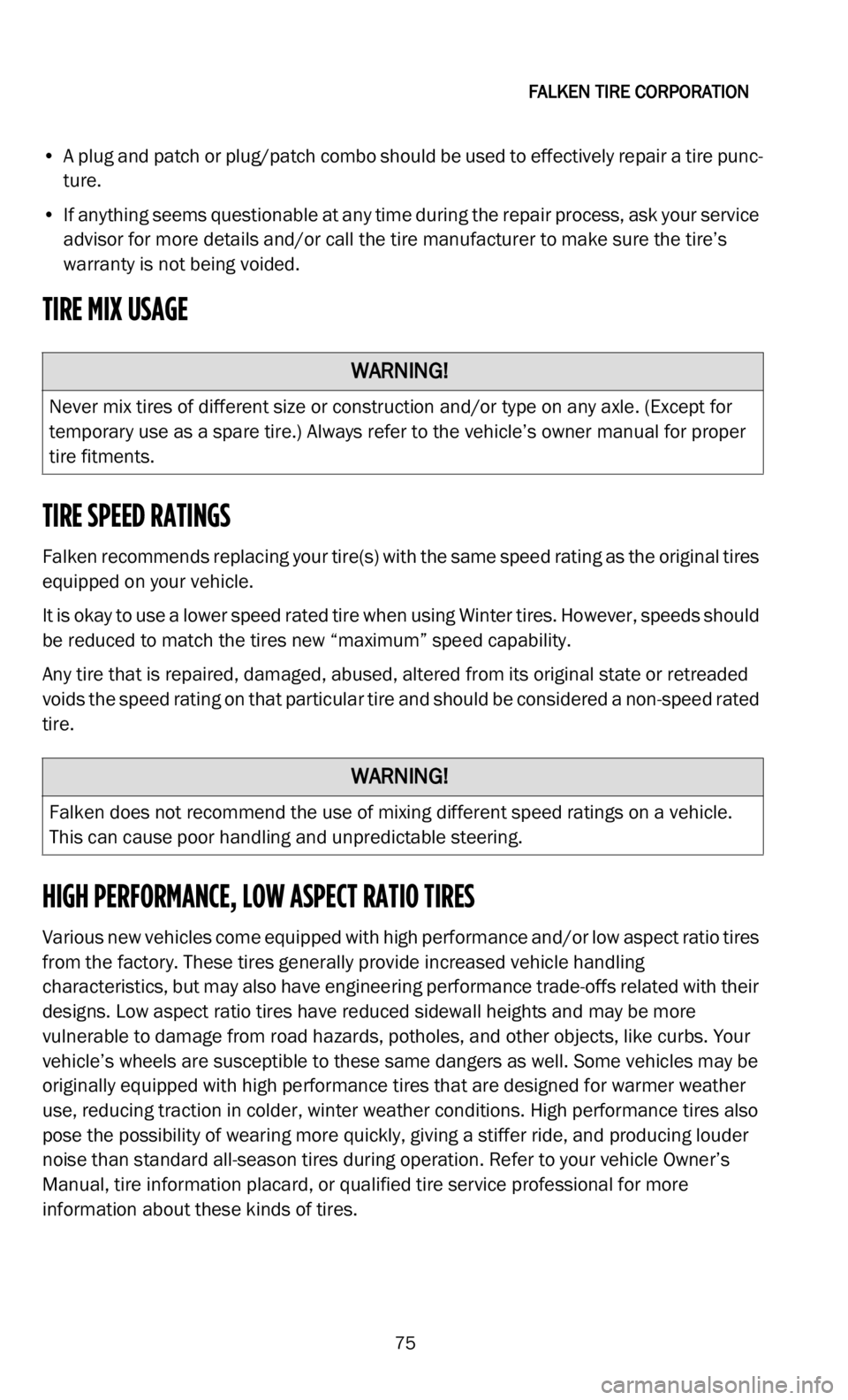
FALKEN TIRE CORPORATION
75
• A plug and patch or plug/patch combo should be used to effectively repair a tire punc -
ture.
• I f anything seems questionable at any time during the repair process, ask your service
a
dvisor for more details and/or call the tire manufacturer to make sure the tire’s
warranty is not being voided.
TIRE MIX USAGE
TIRE SPEED RATINGS
Falken recommends replacing your tire(s) with the same speed rating as the original tires
equipped on your vehicle.
It is okay to use a lower speed rated tire when using Winter tires. However, speeds should
b e
reduced to match the tires new “maximum” speed capability.
Any tire that is repaired, damaged, abused, altered from its original state or retreaded
v o
ids the speed rating on that particular tire and should be considered a non-speed rated
tire.
HIGH PERFORMANCE, LOW ASPECT RATIO TIRES
Various new vehicles come equipped with high performance and/or low aspect ratio tires
from the factory. These tires generally provide increased vehicle handling
characteristics, but may also have engineering performance trade-offs related with their
designs. Low aspect ratio tires have reduced sidewall heights and may be more
vulnerable to damage from road hazards, potholes, and other objects, like curbs. Your
vehicle’s wheels are susceptible to these same dangers as well. Some vehicles may be
originally equipped with high performance tires that are designed for warmer weather
use, reducing traction in colder, winter weather conditions. High performance tires also
pose the possibility of wearing more quickly, giving a stiffer ride, and producing louder
noise than standard all-season tires during operation. Refer to your vehicle Owner’s
Manual, tire information placard, or qualified tire service professional for more
information about these kinds of tires.
WARNING!
Never mix tires of different size or construction and/or type on any axle. (Except for
temporary use as a spare tire.) Always refer to the vehicle’s owner manual for proper
tire fitments.
WARNING!
Falken does not recommend the use of mixing different speed ratings on a vehicle.
This can cause poor handling and unpredictable steering.
Page 82 of 200
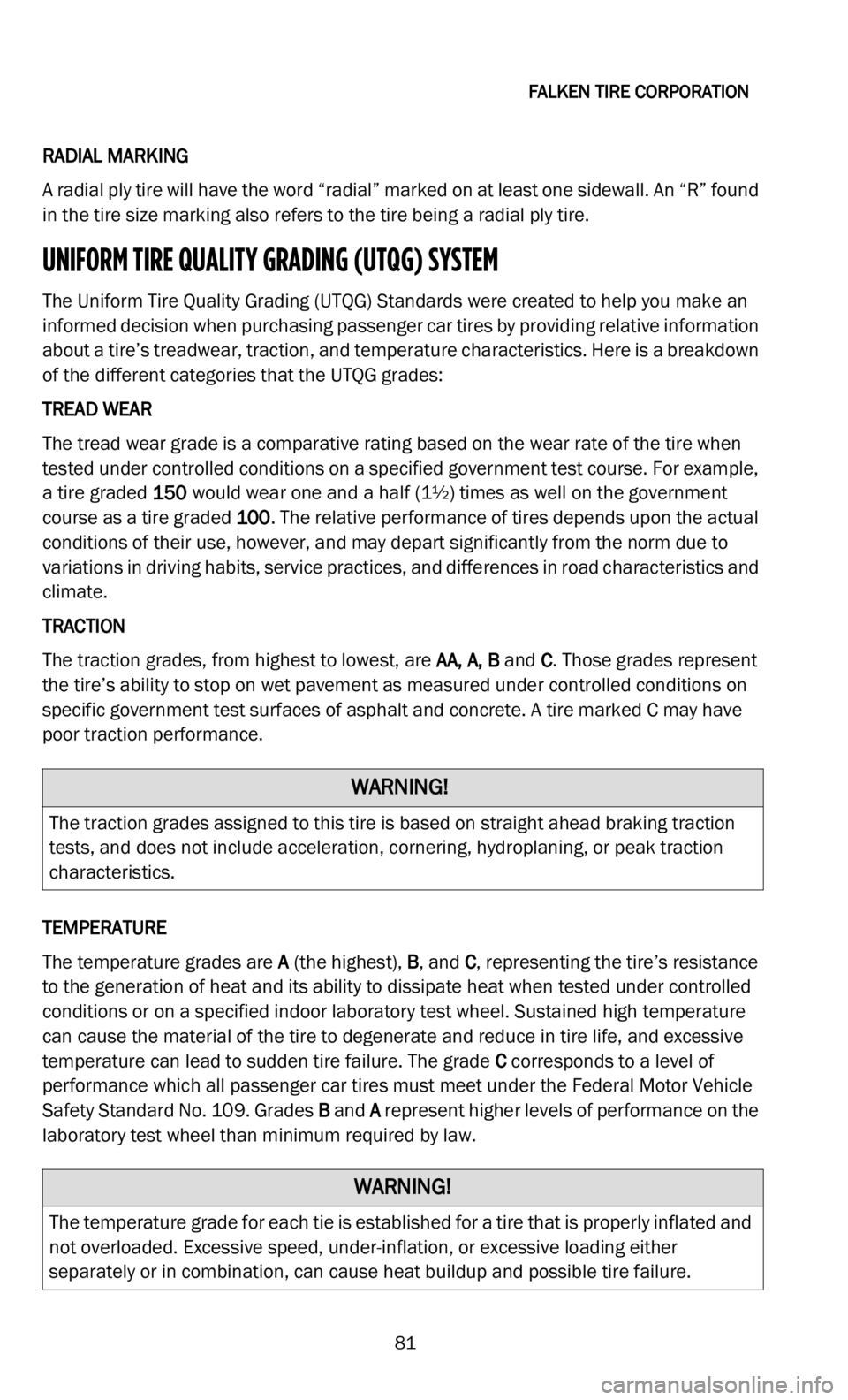
FALKEN TIRE CORPORATION
81
RADIAL MARKING
A radial ply tire will have the word “radial” marked on at least one sidewall. An “R” found
i n
the tire size marking also refers to the tire being a radial ply tire.
UNIFORM TIRE QUALITY GRADING (UTQG) SYSTEM
The Uniform Tire Quality Grading (UTQG) Standards were created to help you make an
informed decision when purchasing passenger car tires by providing relative information
about a tire’s treadwear, traction, and temperature characteristics. Here is a breakdown
of the different categories that the UTQG grades:
TREAD WEAR
The tread wear grade is a comparative rating based on the wear rate of the tire when
te
sted under controlled conditions on a specified government test course. For example,
a tire graded 150 would wear one and a half (1½) times as well on the government
course as a tire graded 100. The relative performance of tires depends upon the actual
conditions of their use, however, and may depart significantly from the norm due to
variations in driving habits, service practices, and differences in road characteristics and
climate.
TRACTION
The traction grades, from highest to lowest, are AA
, A, B and C. Those grades represent
the tire’s ability to stop on wet pavement as measured under controlled conditions on
specific government test surfaces of asphalt and concrete. A tire marked C may have
poor traction performance.
TEMPERATURE
The temperature grades are A
(the highest), B, and C, representing the tire’s resistance
to the generation of heat and its ability to dissipate heat when tested under controlled
conditions or on a specified indoor laboratory test wheel. Sustained high temperature
can cause the material of the tire to degenerate and reduce in tire life, and excessive
temperature can lead to sudden tire failure. The grade C corresponds to a level of
performance which all passenger car tires must meet under the Federal Motor Vehicle
Safety Standard No. 109. Grades B and A represent higher levels of performance on the
laboratory test wheel than minimum required by law.
WARNING!
The traction grades assigned to this tire is based on straight ahead braking traction
tests, and does not include acceleration, cornering, hydroplaning, or peak traction
characteristics.
WARNING!
The temperature grade for each tie is established for a tire that is properly inflated and
not overloaded. Excessive speed, under-inflation, or excessive loading either
separately or in combination, can cause heat buildup and possible tire failure.
Page 97 of 200

GOODYEAR® DUNLOP® TIRES
96
•TIRE SPINNING. On slippery surfaces such as snow, mud, ice, etc., do not spin tires in
excess of 35 mph (55 km/h), as indicated on the speedometer.
• EXCESSIVE WHEEL SPINNING.
This can also result in tire disintegration or axle failure.
TIRE CARE AND MAINTENANCE GUIDE
The easiest way to help ensure satisfactory mileage and performance from your
Goodyear® or Dunlop® tires is to give them a simple but frequent (at least monthly)
inspection for proper inflation, even tread wear and the presence of any damage.
DO MAINTAIN PROPER INFLATION PRESSURE IN YOUR TIRES
Proper inflation pressure is necessary for optimum tire performance, safety and fuel
economy. Check inflation pressures at least once a month and before long trips. Use an
accurate tire pressure gauge. Always check pressures when the tires are cold (when the
vehicle has been driven less than one mile). If you must check inflation when the tires
are hot, add 4 psi (27 kPa) to the recommended cold inflation pressure. It is difficult to
tell just by looking at radial tires whether they are underinflated.*
Furthermore, when operating a vehicle equipped with radial tires, it is difficult to notice
wh
en a tire has gone flat or nearly flat since the “feel” of the vehicle does not change
significantly.
*Evidence of air loss or repeated underinflation always requires expert inspection to
d e
termine the source of leakage and tire removal to determine repairability. To avoid
injury, NEVER attempt to reinflate a tire that has been run severely underinflated.
Progressive air loss may result from punctures, cuts, curbing, impacts or partial bead
unseating. Some fitment causes for air loss are (1) incomplete bead seating, (2) bead
tearing caused by a machine tool due to insufficient lubrication or improper adjustment.
Leaking valve core or rubber valve components should be replaced when problems are
detected and whenever tires are replaced.
WARNING!
Vehicle handling, traction, ride comfort and other performance parameters may be
significantly affected by a change in tire size or type. Before replacing tires, always
consult and follow the vehicle Owner’s Manual because some vehicle manufacturers
prohibit changing tire size. When selecting tires that are different from the original
equipment size make certain:
• The tires have adequate load-carrying capacity based on the vehicle placard.
•
The tires have sufficient inflation pressure to carry the load.
•
There is proper clearance with no interference points between the tire and vehicle.
T
he consumer must be aware to always drive safely and obey all traffic laws. Avoid
s u
dden, sharp turns or aggressive lane changes. Failure to follow any of these
warnings may result in loss of control of the vehicle, leading to an accident and
serious injury or death.
Page 101 of 200
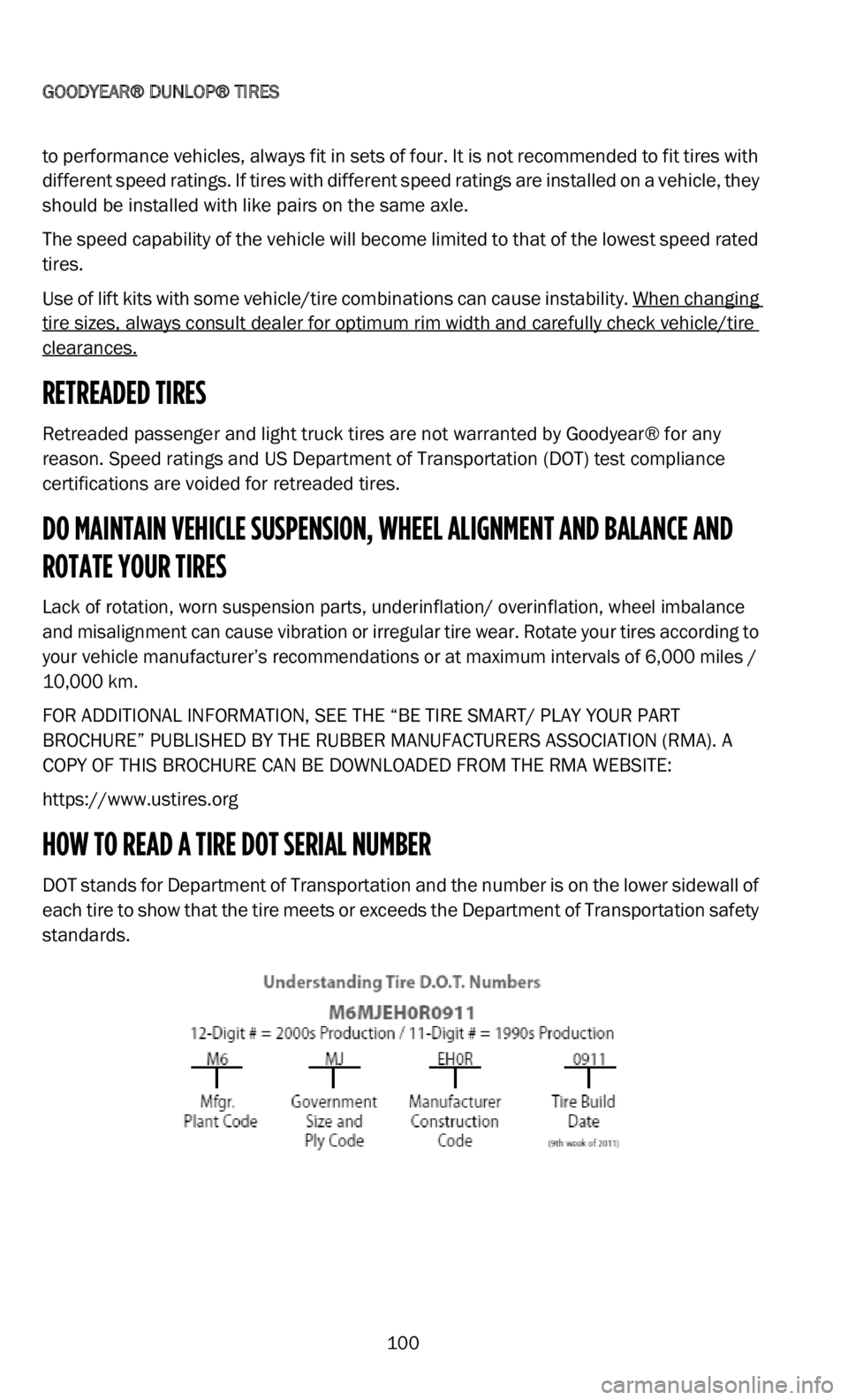
GOODYEAR® DUNLOP® TIRES
100
to performance vehicles, always fit in sets of four. It is not recommended to fit tires with
different speed ratings. If tires with different speed ratings are installed on a vehicle, they
should be installed with like pairs on the same axle.
The speed capability of the vehicle will become limited to that of the lowest speed rated
ti
res.
Use of lift kits with some vehicle/tire combinations can cause instability. When changing
tire sizes, always consult dealer for optimum rim width and carefully check vehicle/tire
clearances.
RETREADED TIRES
Retreaded passenger and light truck tires are not warranted by Goodyear® for any
reason. Speed ratings and US Department of Transportation (DOT) test compliance
certifications are voided for retreaded tires.
DO MAINTAIN VEHICLE SUSPENSION, WHEEL ALIGNMENT AND BALANCE AND
ROTATE YOUR TIRES
Lack of rotation, worn suspension parts, underinflation/ overinflation, wheel imbalance
and misalignment can cause vibration or irregular tire wear. Rotate your tires according to
your vehicle manufacturer’s recommendations or at maximum intervals of 6,000
miles /
1 0
,000 km.
FOR ADDITIONAL INFORMATION, SEE THE “BE TIRE SMART/ PLAY YOUR PART
B R
OCHURE” PUBLISHED BY THE RUBBER MANUFACTURERS ASSOCIATION (RMA). A
COPY OF THIS BROCHURE CAN BE DOWNLOADED FROM THE RMA WEBSITE:
https://www.ustires.org
HOW TO READ A TIRE DOT SERIAL NUMBER
DOT stands for Department of Transportation and the number is on the lower sidewall of
each tire to show that the tire meets or exceeds the Department of Transportation safety
standards.
Page 107 of 200

HANKOOK TIRES
106
WARNING FOR YOUR SAFETY
•TIRE DEMOUNTING AND MOUNTING
Improper tire mounting and inflation procedures may cause tire beads to break
with explosive force during installation of the tire on the rim, causing personal
injury and property damage. Follow the US Tire Manufacturers Association
(USTMA) installation and safety procedure for mounting and inflating tires. Tire
and rim must match in size. Rim parts must match by manufacturer’s design.
Clean rim. Lubricate rim and beads. Do not exceed the maximum recommended
pressure to seat beads on rim. Use remote control inflation equipment and infla -
tion cage.
NOTE:
• N ever inflate over 40 psi to seat beads.
•
Mount radial ply tires only on rims designated by wheel manufacturer as suitable
f
or radial tire.
• O nly specially trained persons shall mount tires.
• AIR PRESSURE
Check the pressure in your tires, including your spare, at least monthly, and
always before and during extended driving. Check tires cold (at least three hours
after the vehicle has been stopped and before it is driven more than 1 mile or
1.6 kilometers). Do not reduce pressure when tires are hot, use an accurate air
p r
essure gauge to check pressure and maintain it at the level recommended on
the vehicle tire placard or in the Owner’s Manual. Underinflation produces
extreme flexing of sidewalls and builds up heat to the point that premature tire
failure may occur. Overinflation can cause the tires to be more susceptible to
impact damage. Cold tire pressures, however, should never be higher than the
limit molded on the sidewall.
• LOAD LIMITS
Never exceed the load-carrying limits molded onto the sidewall of your tires or the
maximum vehicle load limit as shown on the vehicle tire placard, whichever is
less. Overloading builds up excessive heat in the tire and leads to early and/or
sudden failure.
•HAZARDS
Avoid running over objects (e.g., chuckholes, rocks, curbs, metal, glass, etc.)
which may possibly cause internal tire damage. Continued use of a tire that has
suffered internal damage (which may not be externally visible) can lead to
dangerous tire failure. Determination of suspected internal damage requires
demounting the tire from its rim and examination by trained tire personnel.
•WORN TIRES
Never drive on worn tires. Tires should be replaced by trained personnel when
2/32 of an inch (1.6 mm) of tread depth remain, as indicated by treadwear indi -
cators molded into the tread grooves. Use of worn-out tires (less than 2/32 of an
i n
ch remaining tread depth) increases the probability of tire failure. In most
states, it is illegal to drive with less than 2/32 of an inch of remaining tread depth.